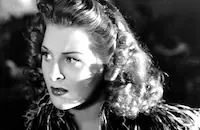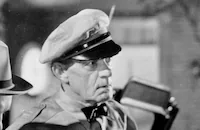The Mad Ghoul
Brief Synopsis
Cast & Crew
James Hogan
David Bruce
Evelyn Ankers
George Zucco
Robert Armstrong
Turhan Bey
Photos & Videos
Film Details
Technical Specs

Synopsis
Dr. Alfred Morris lectures his chemistry students about the possibility that the ancient Mayans discovered a poisonous gas that caused a state of "death in life." After class, Morris tells his prize pupil, medical student Ted Allison, that he has recreated the native formula and asks Ted to work as his assistant. That afternoon, after the two listen to Ted's fiancée, singer Isabel Lewis, perform on the radio, Morris demonstrates the ancient gas's effect on a monkey. He then tells Ted that he has theorized that the Mayans were able to reverse the effects of the gas with the mixture of herbs and heart fluids. After Ted performs an operation on another monkey, Morris revives the first monkey from its zombie-like state. That night, Morris invites Ted and Isabel to his home for dinner, and he tells the singer he knows that she is no longer in love with Ted. The love-struck Morris then tells Isabel that he can arrange for Ted to break off their engagement. The next morning, Morris gases Ted with the Mayan formula, turning the medical student into an obedient zombie. After convincing the helpless Ted that Isabel is no longer interested in him, Morris calls the singer and bids her farewell as she leaves on a concert tour. That night, Morris and Ted rob a grave, and after Ted removes the corpse's heart, Morris returns the medical student to his normal state, with no memory of having been a zombie. Because of the grave robbery, however, Sergeant Macklin leads a police investigation, which is closely followed by reporter Ken McClure. Later, after the experimental monkey has a relapse, Morris realizes that he has only discovered a temporary cure to the gas, and when Ted insists on joining Isabel on tour, the mad chemist agrees to go as well. Backstage after her concert, Ted asks Isabel to marry him, but when she hesitates to answer, he suffers a relapse and again becomes a zombie. Morris then takes Ted to a nearby cemetery in the hope of finding another corpse. There the chemist kills the caretaker and has Ted remove his heart. Later, Isabel confesses to Morris her love for her pianist, Eric Iverson, and after forcing Ted into another relapse, the jealous Morris orders the zombie to kill Eric. He is unable to murder the pianist, however, when Isabel appears. Meanwhile, Ken discovers that "the mad ghoul" has been following Isabel's tour schedule, so he arranges to pretend to be a corpse in the mortuary of the next town on the tour. Morris falls for Ken's trap, but the reporter himself is killed when he fails to see Ted behind him. Returning home, Isabel is questioned by Macklin, who suspects that Eric is the killer. Hearing the description of the scientific and surgical skills of the killer, Isabel suspects Ted of the killings and mutilations, and she goes to Morris for help. Ted walks in on their conversation, and suddenly realizes the truth about himself. After writing a suicide note, Ted lures Morris into the laboratory and exposes the chemist to his own formula. Ted then suffers a relapse and is ordered by Morris to kill Eric, then himself. It is not until Ted leaves, however, that Morris realizes that he has been exposed to the formula. Morris then rushes to the concert hall and begs Ted to help him exhume another body, but the zombie is enveloped by his order to kill Eric and walks on stage during Isabel's concert. Ted himself is killed, however, by the police in attendance, while Morris, still a zombie, dies when he is unable to unearth a fresh grave on his own.

Director
James Hogan
Cast
David Bruce

Evelyn Ankers

George Zucco

Robert Armstrong

Turhan Bey

Milburn Stone
Andrew Tombes

Rose Hobart

Addison Richards

Charles Mcgraw
Gus Glassmire
Gene O'donnell
Isabelle La Mal

Lew Kelly
William Ruhl
Hans Herbert
Crew
Michael William Balfe
Bernard B. Brown
Alfred Bunn
Milton Carruth
Everett Carter
Paul Gangelin
R. A. Gausman
Joseph Gershenson
A. J. Gilmore
John B. Goodman
William Holland
Hans Kraly
Milton Krasner
Jess Moulin
Martin Obzina
Benjamin Pivar
Milton Rosen
H. J. Salter
Peter Ilyich Tchaikovsky
Brenda Weisberg
Vera West

Photo Collections
Film Details
Technical Specs

Articles
The Mad Ghoul
Like Lionel Atwill, George Zucco was a classically trained stage actor who ended up being typecast in horror films as mad doctors and insane scientists. His first official starring role in the genre, though he had already played villains in films such as The Adventures of Sherlock Holmes (1939), was The Monster and the Girl (1941). Zucco's wild-eyed stare, flamboyant gestures and imposing voice made him an ideal madman but it also stereotyped him to such a degree that he was mostly only offered low-budget horror films or thrillers by the mid-forties. Unlike Atwill, he appeared in a large number of low quality pictures for poverty row outfits like Monogram and PRC such as Voodoo Man (1944) and The Flying Serpent (1946). Yet his performance in The Mad Ghoul is a model of restraint and intelligence that gives the movie a distinctive advantage over its competition.
In addition, David Bruce's performance as the doomed Ted lends The Mad Ghoul a sense of genuine tragedy and the macabre that stays with you. Prior to this movie, Bruce was an attractive leading man in B movies with a busy if undistinguished career. The Mad Ghoul elevated Bruce to cult status among horror buffs, and though he would appear in similar Universal releases such as Calling Dr. Death (1943) and The Mummy's Ghost (1944), he would never match his creepy, haunting appearance here: "What am I? Alive or dead? Man or beast? What have you done to me?"
Bruce's gruesome makeup was designed by the legendary Jack Pierce who was responsible for creating the look of some of the most famous Universal monsters including Frankenstein, Dracula, The Mummy and the Wolf Man. In a later interview Pierce stated that the only direction the filmmakers gave him about Bruce's ghoul makeup was that he look like a fresh cadaver. Pierce obliged them and not only tinted Bruce's skin green but also applied a layer of false skin on the actor that proved to be difficult and painful to remove later. Turhan Bey, who plays the musician who becomes Isabel's fiancée in The Mad Ghoul, was a legendary ladies' man in Hollywood, linked romantically with Lana Turner, among many others, and had an exotic screen presence. Bey later had fond memories working with George Zucco and with the film's director James Hogan and producer Ben Pivar, whom he admired as one of the many musician/ producers working at Universal at the time. The Mad Ghoul, by the way, was scored by Hans J. Salter, a six-time Academy Award nominee, who also composed the music for such Universal horrors as Man Made Monste (1941), The Wolf Man (1941), The Ghost of Frankenstein (1942), Son of Dracula (1943) and many more.
As was typical of its era, The Mad Ghoul, being a horror film, was immediately dismissed by mainstream movie critics as junk. Bosley Crowther of The New York Times wrote, "Most of the ghouls we've met in horror films have been more or less scatter-brained, so there's really nothing out of the ordinary about the one in Universal's The Mad Ghoul, which came clomping and goggle-eyeing into the Rialto yesterday. He is just another poor unfortunate who has been turned into a walking fiend by another maniacal scientist who has discovered some peculiar witching-gas. And the nature of his madness is no different from that of any ghoul who has gone clawing around among cadavers and generally making a nuisance of himself. As a matter of fact, we would call him a definitely second-rate ghoul. And if anyone is privileged to be crazy, it's us poor folks who have to look at such things." By today's standards, however, The Mad Ghoul remains a remarkably stylish genre outing that is distinguished by Milton Krasner's imaginative camerawork and excellent performances from Zucco, Bruce, and Ankers.
Director: James P. Hogan
Screenplay: Paul Gangelin, Brenda Weisberg; Hanns Kraly (story)
Cinematography: Milton R. Krasner
Art Direction: John B. Goodman, Martin Obzina
Music: Hans J. Salter
Film Editing: Milton Carruth
Principal Cast: David Bruce (Ted Allison), Evelyn Ankers (Isabel Lewis), George Zucco (Dr. Alfred Morris), Robert Armstrong ('Scoop' McClure), Turhan Bey (Eric Iverson), Milburn Stone (Sgt. Macklin), Andrew Tombes (Egan, mortician), Rose Hobart (Della Elliot, reporter), Addison Richards (Editor Gavigan), Charles McGraw (Det. Garrity), Gus Glassmire (First cemetery caretaker).
BW-65m.
by Jeff Stafford
SOURCES:
AFI Catalog of Feature Films
Universal Horrors: The Studio's Classic Films, 1931-1946 by Michael Brunas, John Brunas and Tom Weaver (McFarland & Associates)
Horror Film Stars by Michael R. Pitts (McFarland & Associates)

The Mad Ghoul
Quotes
For goodness sake, whatever you do, don't mar the coffin!- Egan (mortician
Trivia
Notes
The working title of this film was The Mystery of the Mad Ghoul. Director James Hogan died of a heart attack shortly before the release of this film. Modern sources state that Jack P. Pierce was the makeup artist and that Lillian Cornell was the vocalist whose singing was dubbed for Evelyn Ankers, and include Bess Flowers and Cyril Ring in the cast.














